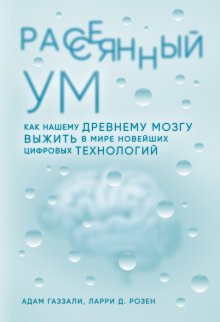Ларри Розен - Рассеянный ум

Все авторские права соблюдены. Напишите нам, если Вы не согласны.
Описание книги "Рассеянный ум"
Описание и краткое содержание "Рассеянный ум" читать бесплатно онлайн.
19
E. S. Bromberg-Martin and O. Hikosaka, “Midbrain Dopamine Neurons Signal Preference for Advance Information about Upcoming Rewards,” Neuron 63, no. 1 (2009): 119–126.
20
T. T. Hills, “Animal Foraging.”
21
P. Pirolli and S. Card, “Information Foraging,” Psychological Review 106, no. 4 (1999): 643.
22
E. L. Charnov, “Optimal Foraging: The Marginal Value Theorem,” Theoretical Population Biology 9, no. 2 (1976): 129–136.
23
M. H. Cassini, A. Kacelnik, and E. T. Segura, “The Tale of the Screaming Hairy Armadillo, the Guinea Pig, and the Marginal Value Theorem,” Animal Behavior 39, no. 6 (1990: 1030–1050; R. J. Cowie, “Optimal Foraging in the Great Tits (Parus Major),” Nature 268 (1977): 137–139.
24
Pirolli and Card, “Information Foraging”; T. Hills, P. M. Todd, and R. L. Goldstone, “Priming and Conservation between Spatial and Cognitive Search,” in Proceedings of the 29th Annual Cognitive Science Society (Austin: Cognitive Science Society, 2007), 359–364; P. E. Sandstrom, “An Optimal Foraging Approach to Information Seeking and Use,” Library Quarterly (1994): 414–449; M. Dwairy, A. C. Dowell, and J. C. Stahl, “The Application of Foraging Theory to the Information Searching Behavior of General Practitioners,” BMC Family Practice, 12, no. 1 (2011): 90.
25
R. Marois and J. Ivanoff, “Capacity Limits of Information Processing in the Brain,” Trends in Cognitive Sciences 9, no. 6 (2005): 296–305.
26
J. M. Fuster, “Upper Processing Stages of the Perception-Action Cycle,” Trends in Cognitive Sciences 8, no. 4 (2004): 143–145.
27
Термин «цикл восприятия/действия» был введен и популяризован Хоакином Фустером, но концепция Упоминалась несколькими другими учеными, начиная с 1950 года. See J. M. Fuster, The Prefrontal Cortex, 2nd ed. (New York: Raven Press, 1989); J. M. Fuster, Cortex and Mind: Unifying Cognition (Oxford: Oxford University Press, 2003).
28
Подколенный рефлекс можно точнее описать как рефлекс ощущения/действия, так как головной мозг не принимает участия в процессе.
29
F. L. Coolidge and T. Wynn, “Executive Functions of the Frontal Lobes and the Evolutionary Ascendancy of Homo Sapiens,” Cambridge Archeological Journal 11, no. 2 (2001): 255–260.
30
N. J. Emery and N. S. Clayton, “The Mentality of Crows: Convergent Evolution of Intelligence in Corvids and Apes,” Science 306, no. 5703 (2004): 1903–1907.
31
Quoted material in this paragraph is from Charles Sabine, “Senses Helped Animals Survive the Tsunami,” NBC News with Brian Williams, http://www.nbcnews.com/id/6795562/ns/nbc_nightly_news_with_brian_williams/t/senses-helped-animals-survive-tsunami.
32
National Highway Traffic Safety Administration and Virginia Tech Transportation Institute, “Breakthrough Research on Real-World Driver Behavior Released,” April 20, 2006, http://www.nhtsa.gov/Driving+Safety/Distracted+Driving+at+Distraction.gov/Breakthrough+Research+on+Real-World+Driver+Behavior+Released.
33
William James, Principles of Psychology (New York: Holt, 1890), 404.
34
S. J. Luck and S. P. Vecera, “Attention,” in Stevens’ Handbook of Experimental Psychology, vol. 1: Sensation and Perception, ed. H. Pasher and S. Yantis (New York: John Wiley, 2002), 235–286.
35
A. Baddeley, Working Memory (Oxford: Oxford University Press, 1986).
36
A. Gazzaley and A. C. Nobre, “Top-Down Modulation: Bridging Selective Attention and Working Memory,” Trends in Cognitive Sciences 16, no. 2 (2012): 129–135.
37
D. Premack, “Human and Animal Cognition: Continuity and Discontinuity,” Proceedings of the National Academy of Sciences of the United States of America 104, no. 35 (2007): 13861–13867.
38
A. Gazzaley and M. D’Esposito, “Unifying Prefrontal Cortex Function: Executive Control, Neural Networks, and Top-Down Modulation,” in The Human Frontal Lobes, ed. B. Miller and J. Cummings (New York: Guilford, 2007).
39
G. Fritsch and E. Hitzig, “Uber die elektrische Erregbarkeit des Grosshiirns,” Archiv der Anatomie, Physiologie und Wissenschaftlichen Medizin 37 (1870): 300–332.
40
B. J. Baars and N. M. Gage, Cognition, Brain, and Consciousness: Introduction to Cognitive Neuroscience (New York: Academic Press, 2010).
41
A. M. Glenberg, J. L. Schroeder, and D. A. Robertson, “Averting the Gaze Disengages the Environment and Facilitates Remembering,” Memory and Cognition 26 (1998): 651–658.
42
P. E. Wais, M. T. Rubens, J. Boccanfuso, and A. Gazzaley, “Neural Mechanisms Underlying the Impact of Visual Distraction on Retrieval of Long-Term Memory,” Journal of Neuroscience 30, no. 25 (2010): 8541–8550.
43
H. J. Bigelow, “Dr. Harlow’s Case of Recovery from the Passage of an Iron Bar through the Head,” American Journal of the Medical Sciences 16, no. 39 (1850): 13–22. See also the Phineas Gage Information Page at http://www.uakron.edu/gage.
44
H. Damasio, T. Grabowski, R. Frank, A. M. Galaburda, and A. R. Damasio, “The Return of Phineas Gage: Clues about the Brain from the Skull of a Famous Patient,” Science 264, no. 5162 (1994): 1102–1105.
45
Harlow, “Recovery from the Passage of an Iron Bar through the Head”; reprinted as J. M. Harlow, Recovery from the Passage of an Iron Bar through the Head (Boston: David Clapp & Son), 13.
46
G. A. Mashour, E. E. Walker, and R. L. Martuza, “Psychosurgery: Past, Present, and Future,” Brain Research Reviews 48, no. 3 (2005): 409–419.
47
W. Freeman and J. W. Watts, “Physiological Psychology,” Annual Review of Physiology 6, no. 1 (1944): 517–542.
48
W. Freeman and J. W. Watts, “Physiological Psychology”.
49
A. L. Benton, “Differential Behavioral Effects in Frontal Lobe Disease,” Neuropsychologia 6, no. 1 (1968): 53–60; A. R. Luria, Human Brain and Psychological Processes (New York: Harper & Row, 1968); B. Milner, “Effects of Different Brain Regions on Card Sorting,” Archives of Neurology 9 (1963): 90–100.
50
P. T. Schoenemann, M. J. Sheehan, and L. D. Glotzer, “Prefrontal White Matter Volume Is Disproportionately Larger in Humans Than in Other Primates,” Nature Neuroscience 8, no. 2 (2005): 242–252.
51
A. Gazzaley and M. D’Esposito, “Neural Networks: An Empirical Neuroscience Approach toward Understanding Cognition,” Cortex 42, no. 7 (2006): 1037–1040.
52
J. van Whye, “The History of Phrenology on the Web” (2004), http://www.historyofphrenology.org.uk/.
53
E. A. Berker, A. H. Berker, and A. Smith, “Translation of Broca’s 1865 Report: Localization of Speech in the Third Left Frontal Convolution,” Archives of Neurology 43, no. 10 (1986): 1065–1072.
54
R. M. Sabbatini, “Phrenology: The History of Brain Localization,” Brain and Mind 1 (1997), http://www.cerebromente.org.br/n01/frenolog/frenologia.htm.
55
B. Tizard, “Theories of Brain Localization from Flourens to Lashley,” Medical History 3 (1959): 132–145.
56
J. M. Fuster, Cortex and Mind: Unifying Cognition (Oxford: Oxford University Press, 2003).
57
M. Mesulam, “A Cortical Network for Directed Attention and Unilateral Neglect,” Annals of Neurology 10, no. 4 (1981): 309–325.
58
Gazzaley and D’Esposito, “Unifying Prefrontal Cortex Function.”
59
A. Gazzaley, J. W. Cooney, K. McEvoy, R. T. Knight, and M. D’Esposito, “Top-Down Enhancement and Suppression of the Magnitude and Speed of Neural Activity,” Journal of Cognitive Neuroscience 17, no. 3 (2005): 507–517.
60
E. K. Miller and J. D. Cohen, “An Integrative Theory of Prefrontal Cortex Function,” Annual Review of Neuroscience 24, no. 1 (2001): 167–202.
61
Левое полушарие мозга отображает правостороннее видение мира, поэтому зрительная кора правого полушария соответствует левостороннему зрительному полю, куда направлено внимание нашего предка.
62
Gazzaley et al., “Top-Down Enhancement.”
63
J. Z. Chadick, T. P. Zanto, and A. Gazzaley, “Structural and Functional Differences in Medial Prefrontal Cortex Underlie Distractibility and Suppression Deficits in Ageing,” Nature Communications 5 (2014): 4223.
64
J. Rissman, A. Gazzaley, and M. D’Esposito, “Measuring Functional Connectivity during Distinct Stages of a Cognitive Task,” Neuroimage 23, no. 2 (2004): 752–763.
65
A. Gazzaley, J. Rissman, and M. D’Esposito, “Functional Connectivity during Working Memory Maintenance,” Cognitive, Affective, and Behavioral Neuroscience 4, no. 4 (2004): 580–599.
66
T. P. Zanto, M. T. Rubens, A. Thangavel, and A. Gazzaley, “Causal Role of the Prefrontal Cortex in Top-Down Modulation of Visual Processing and Working Memory,” Nature Neuroscience 14, no. 5 (2011): 656–661.
67
C. F. Jacobsen, “Studies of Cerebral Function in Primates,” Comparative Psychology Monographs 13 (1938): 1–68.
68
J. M. Fuster and G. E. Alexander, “Neuron Activity Related to Short-Term Memory,” Science 173, no. 3997 (1971): 652–654; K. Kubota and H. Niki, “Prefrontal Cortical Unit Activity and Delayed Alternation Performance in Monkeys,” Journal of Neurophysiology 34 (1971): 337–347.
69
P. S. Goldman-Rakic, “Cellular Basis of Working Memory,” Neuron 14, no. 3 (1995): 477–485.
70
J. M. Fuster, R. H. Bauer, and J. P. Jervey, “Functional Interactions between Inferotemporal and Prefrontal Cortex in a Cognitive Task,” Brain Research 330, no. 2 (1985): 299–307.
71
P. E. Dux, J. Ivanoff, C. L. Asplund, and R. Marois, “Isolation of a Central Bottleneck of Information Processing with Time-Resolved fMRI,” Neuron 52, no. 6 (2006): 1109–1120.
72
P. E. Dux, J. Ivanoff, C. L. Asplund, and R. Marois, “Isolation of a Central Bottleneck of Information Processing with Time-Resolved fMRI,” Neuron 52, no. 6 (2006): 1109–1120.
73
R. Kanai, M. Y. Dong, B. Bahrami, and G. Rees, “Distractibility in Daily Life Is Reflected in the Structure and Function of Human Parietal Cortex,” Journal of Neuroscience 31, no. 18 (2011): 6620–6626.
74
R. Desimone and J. Duncan, “Neural Mechanisms of Selective Visual Attention,” Annual Review of Neuroscience 18, no. 1 (1995): 193–222.
75
T. P. Zanto and A. Gazzaley, “Neural Suppression of Irrelevant Information Underlies Optimal Working Memory Performance,” Journal of Neuroscience 29, no. 10 (2009): 3059–3066.
76
E. K. Vogel, A. W. McCollough, and M. G. Machizawa, “Neural Measures Reveal Individual Differences in Controlling Access to Working Memory,” Nature 438, no. 7067 (2005): 500–503.
77
A. M. Glenberg, J. L. Schroeder, and D. A. Robertson, “Averting the Gaze Disengages the Environment and Facilitates Remembering,” Memory and Cognition 26 (1998): 651–658.
78
P. E. Wais, M. T. Rubens, J. Boccanfuso, and A. Gazzaley, “Neural Mechanisms Underlying the Impact of Visual Distraction on Retrieval of Long-Term Memory,” Journal of Neuroscience 30, no. 25 (2010): 8541–8550.
Подписывайтесь на наши страницы в социальных сетях.
Будьте в курсе последних книжных новинок, комментируйте, обсуждайте. Мы ждём Вас!
Похожие книги на "Рассеянный ум"
Книги похожие на "Рассеянный ум" читать онлайн или скачать бесплатно полные версии.
Мы рекомендуем Вам зарегистрироваться либо войти на сайт под своим именем.
Отзывы о "Ларри Розен - Рассеянный ум"
Отзывы читателей о книге "Рассеянный ум", комментарии и мнения людей о произведении.






